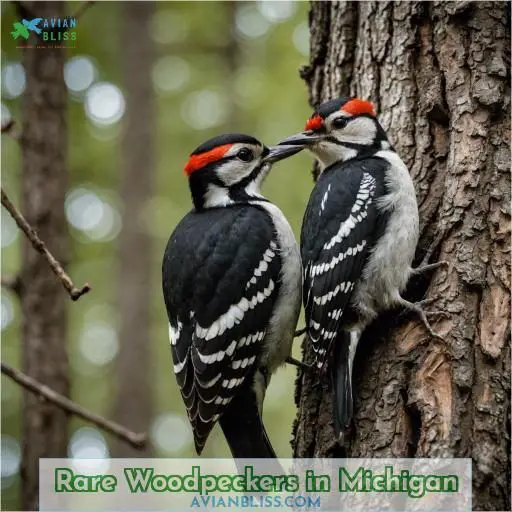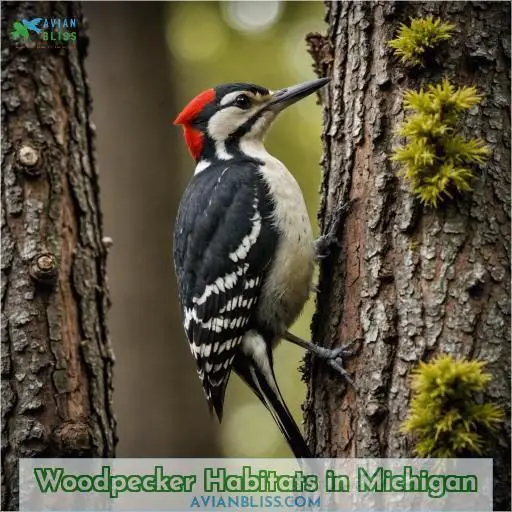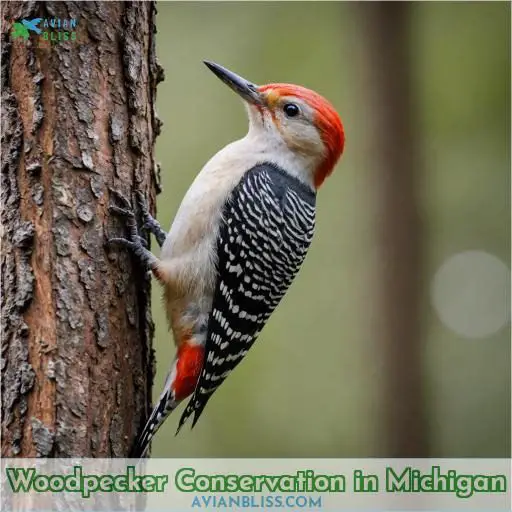This site is supported by our readers. We may earn a commission, at no cost to you, if you purchase through links.
 Michigan is a paradise for woodpecker enthusiasts, boasting diverse species that add color and life to its forests.
Michigan is a paradise for woodpecker enthusiasts, boasting diverse species that add color and life to its forests.
You’ll encounter the diminutive Downy, with its bold head markings, and the zebra-patterned Red-bellied Woodpecker.
The Northern Flicker‘s buff underparts and the Hairy Woodpecker’s loud drumming are unforgettable sights and sounds.
The state’s star attraction is the majestic Pileated Woodpecker, with its impressive red crest.
Rare gems like the Red-headed and Yellow-bellied Sapsucker might also grace your backyard.
Discover the habitats, attractants, and conservation efforts that support these striking woodpeckers of Michigan in the following sections.
Table Of Contents
- Key Takeaways
- Woodpeckers of Michigan
- Rare Woodpeckers in Michigan
- Woodpecker Habitats in Michigan
- Attracting Woodpeckers to Your Yard
- Woodpecker Conservation in Michigan
- Frequently Asked Questions (FAQs)
- What is the rare woodpecker in Michigan?
- What is the big red headed bird in Michigan?
- Are northern flickers common in Michigan?
- What is a Red-headed Woodpecker with a gray body?
- How do woodpeckers avoid brain damage from pecking?
- Can woodpeckers learn to recognize individual humans?
- Do woodpeckers have any natural predators in Michigan?
- How do woodpeckers communicate with each other?
- What is the average lifespan of a woodpecker in the wild?
- Conclusion
Key Takeaways
- Michigan is home to diverse woodpecker species, including the diminutive Downy, the striking Red-bellied, the large Northern Flicker, and the majestic Pileated Woodpecker.
- Rare woodpeckers like the Red-headed, Yellow-bellied Sapsucker, and Black-backed Woodpecker can also be found in the state, offering exciting birdwatching opportunities.
- Woodpeckers thrive in various habitats in Michigan, from pine forests and wooded swamps to parks and urban gardens, highlighting the importance of preserving diverse ecosystems.
- Attracting woodpeckers to your yard can be achieved by providing suet feeders, offering nuts and seeds, and creating nesting habitat, while supporting conservation efforts is crucial for maintaining healthy woodpecker populations.
Woodpeckers of Michigan
You’re likely familiar with the striking Downy Woodpecker, the smallest woodpecker in Michigan, identifiable by its black-and-white plumage and bold head markings. Another common sight is the Red-bellied Woodpecker, with its zebra-like barring and reddish belly that sets it apart from other woodpeckers.
Downy Woodpecker
The diminutive Downy Woodpecker is a delightful backyard visitor in Michigan. This small, black-and-white bird:
- Nests in dead trees, excavating its own cavities for raising young.
- Plays a crucial role in controlling insect populations by foraging on tree bark and branches.
- Thrives in diverse habitats, making it an important indicator species for healthy ecosystems.
Attracting and protecting Downy Woodpeckers helps sustain Michigan’s vibrant woodpecker populations.
Red-bellied Woodpecker
The striking Red-bellied Woodpecker is a common year-round resident across Michigan’s woodlands. With its bold zebra-like barring and red crown, this handsome bird is a delight to spot. Look for them foraging on tree trunks and visiting backyard feeders. Their diverse diet and adaptability make them a resilient species, though habitat loss remains a concern.
| Wingspan | Length | Mass |
|---|---|---|
| 33 – 42 cm | 23 – 27 cm | 56 – 91 g |
Northern Flicker
The Northern Flicker is a large, striking woodpecker found throughout Michigan. With its buff underparts, black chest patch, and bold white rump, this bird is hard to miss. Northern Flickers prefer open habitats like parks and woodlands, where they forage on the ground for ants and beetles. They’ll also visit backyard feeders for suet and seeds.
Hairy Woodpecker
The Hairy Woodpecker is a striking black-and-white bird that drums loudly on trees, excavating cavities for nesting. This medium-sized woodpecker prefers mature forests, where it hunts insects that threaten the health of trees. Attract Hairy Woodpeckers to your yard by offering suet feeders – they’re one of the eight common woodpecker species found across Michigan according to eBird data.]
Pileated Woodpecker
The Pileated Woodpecker is a true giant of the forest, with its striking black and white plumage and impressive red crest.
These birds are known for their loud, ringing calls and their ability to excavate large, rectangular cavities in dead or dying trees.
They primarily feed on carpenter ants, using their powerful beaks to chisel away at the wood.
Pileated Woodpeckers are year-round residents in Michigan’s mature, evergreen forests, and their conservation is essential for maintaining a healthy ecosystem.
Rare Woodpeckers in Michigan
Among the eleven woodpecker species found in Michigan, the Red-headed Woodpecker, Yellow-bellied Sapsucker, and Black-backed Woodpecker are considered rare sightings. These uncommon birds exhibit unique characteristics, from the Red-headed Woodpecker’s vibrant crimson plumage to the Yellow-bellied Sapsucker’s tree-tapping behavior for extracting sap, offering an exciting opportunity for birdwatchers to observe their specialized adaptations.
Red-headed Woodpecker
The striking red-headed woodpecker is a rare sight in Michigan, preferring the semi-open habitats with mature oak trees found in the southern part of the state. This medium-sized bird boasts a distinctive deep red head, sharp gray bill, and glossy black upperparts with white patches on the wings. Known for its flycatching skills, the red-headed woodpecker also has the unique behavior of storing live insects in tree bark for later consumption.
- Distinctive deep red head and sharp gray bill
- Prefers semi-open habitats with mature oak trees
- Skilled flycatcher that stores live insects in tree bark
Yellow-bellied Sapsucker
The Yellow-bellied Sapsucker is a rare woodpecker species found in Michigan. These birds are known for their unique behavior of drilling rows of small holes in tree bark to drink the sap. While their habitat is under threat from deforestation, conservation measures are essential to protect this ecologically significant species. They also occasionally visit backyard feeders in search of nectar.
- Drills rows of small holes in trees to drink sap
- Migratory, found in Michigan during spring and fall
- Habitat threatened by deforestation and destruction
- Conservation efforts important to protect this species
Black-backed Woodpecker
The Black-backed Woodpecker is a rare sight in Michigan, but its distinctive facial stripe and jet-black upperparts make it a striking bird to spot. This medium-sized woodpecker prefers the coniferous forests of the state, where it plays a key role in controlling insect populations through its nesting cavity excavation habits. Preserving these habitats is essential for protecting this unique woodpecker species.
- Distinctive facial stripe and jet-black upperparts
- Prefers coniferous forest habitats in Michigan
- Plays a key role in controlling insect populations
- Excavates nesting cavities in mature trees
Woodpecker Habitats in Michigan
Woodpeckers aren’t confined to deep forests; you can find them thriving in pine forests, wooded swamps, parks, and even urban gardens within Michigan. Their diverse habitats cater to their different nesting and foraging needs, from the towering pines favored by the Pileated Woodpecker to the decaying trees sought by the Downy Woodpecker for insects and nesting cavities.
Pine Forests
The pine forests of Michigan provide an ideal habitat for several woodpecker species. The dense canopy of pine needles offers ample nesting opportunities, while the thick bark provides a rich source of insects for foraging. Woodpeckers can be observed tapping on the trees, excavating cavities, and probing the bark for their next meal in this conifer-dominated landscape.
| Nesting | Foraging | Habitat |
|---|---|---|
| Woodpeckers utilize the cavities in pine trees for nesting | Bark-dwelling insects and larvae are a primary food source | Pine forests offer a dense, coniferous environment well-suited for woodpeckers |
Wooded Swamps
Wooded swamps provide an ideal habitat for several woodpecker species in Michigan.
These birds thrive in the dense, mature forests, foraging on insects and larvae within the decaying trees.
Pileated Woodpeckers, in particular, favor these wetland environments. They excavate large nesting cavities in the towering trunks.
Preserving and restoring these essential swamp ecosystems is paramount for maintaining healthy woodpecker populations across the state.
Parks and Gardens
Woodpeckers flourish in parks and gardens, where they can find plentiful food and nesting sites. These lively birds gather at backyard suet feeders, enthusiastically pecking away at the energy-rich treats. Providing nesting boxes and preserving dead trees standing establishes essential habitat for woodpeckers to nurture their young. By safeguarding green spaces, you can invite these captivating birds into your own backyard sanctuary.
- Entice woodpeckers with suet feeders and nut-based treats
- Offer nesting boxes to facilitate breeding and roosting
- Preserve dead and dying trees for natural foraging and nesting
- Maintain diverse, wooded landscapes to sustain healthy woodpecker populations
Attracting Woodpeckers to Your Yard
To attract woodpeckers to your yard, provide suet feeders stocked with high-energy suet cakes, as well as specialty feeders filled with nuts or seeds. Creating a habitat with dead or dying trees also offers nesting opportunities that appeal to woodpeckers.
Provide Suet Feeders
Providing suet feeders is a surefire way to attract woodpeckers to your yard.
Offer a variety of suet flavors like peanut butter, mealworm, or fruit to cater to their diverse tastes.
Place feeders near trees or on tree trunks for easy access.
Suet is especially important during the winter when natural food sources are scarce.
You can even make your own homemade suet cakes or opt for suet alternatives like peanuts or sunflower seeds.
Offer Nuts and Seeds
In addition to suet feeders, offering nuts and seeds is a great way to attract woodpeckers to your yard. Fill specialty feeders with high-energy suet cakes, peanuts, sunflower seeds, and other nuts. Woodpeckers like the Red-bellied and Hairy Woodpecker will readily visit these feeders, providing you with hours of birdwatching enjoyment.
Create Nesting Habitat
To create nesting habitat and attract woodpeckers to your yard, consider installing nest boxes or leaving dead trees standing. Woodpeckers are cavity nesters, so providing these structures can boost species diversity. However, be mindful of habitat loss – preserving mature forests is essential for supporting healthy woodpecker populations in Michigan.
Woodpecker Conservation in Michigan
To safeguard Michigan’s woodpecker populations, these fascinating birds are protected under the Migratory Bird Treaty Act. By regulating activities that could harm woodpeckers, this act helps maintain their essential role in controlling insect populations and promoting healthy forest ecosystems.
Protected Under Migratory Bird Treaty Act
Woodpeckers in Michigan are protected under the Migratory Bird Treaty Act, which prohibits the hunting, killing, or possession of these birds. This law helps conserve woodpecker populations by safeguarding their habitats. By preserving forests and trees, we can guarantee these birds continue to provide valuable ecosystem services, like controlling insect populations.
| Migratory Bird Treaty Act | Habitat Preservation |
|---|---|
| Prohibits hunting, killing, or possession of woodpeckers | Ensures availability of nesting sites and food sources |
| Protects woodpecker populations | Maintains healthy tree populations |
| Enforced by state and federal agencies | Essential for long-term conservation efforts |
Importance in Ecosystem Health
Woodpeckers play a crucial role in maintaining ecosystem health. Their diverse diet of insects, nuts, and fruits helps regulate pest populations and disperse seeds. Woodpeckers also create nesting cavities used by other birds and animals. Their unique communication through drumming and vocalizations enrich the soundscape. With lifespans up to 16 years, woodpeckers are long-term contributors to their environments.
- Woodpeckers regulate insect populations by feeding on wood-boring beetles, carpenter ants, and other tree-dwelling pests.
- Woodpecker nesting cavities provide homes for owls, bluebirds, and other cavity-nesting species, increasing biodiversity.
- Woodpecker drumming and calls are an integral part of forest soundscapes, contributing to the overall health and vibrancy of ecosystems.
Maintaining Healthy Tree Populations
To maintain healthy tree populations and support woodpecker conservation in Michigan, focus on woodland management practices that preserve mature forests. Plant native tree species, avoid pesticides, and leave standing dead trees for nesting sites. Your backyard can become a haven for these remarkable birds by providing the right habitat.
| Tree Health | Woodland Management | Forest Preservation |
|---|---|---|
| Avoid pesticides | Plant native species | Protect mature trees |
| Provide nesting sites | Manage for diversity | Limit development |
| Control insect pests | Thin overgrown areas | Restore degraded lands |
| Monitor tree condition | Promote regeneration | Collaborate with experts |
| Promote biodiversity | Minimize disturbance | Advocate for policies |
Frequently Asked Questions (FAQs)
What is the rare woodpecker in Michigan?
You’re in for a real rarity! The Red-cockaded Woodpecker, a critically endangered species, may no longer be found in Michigan’s wild forests. Cherish the chance to glimpse this elusive beauty if you ever encounter it.
What is the big red headed bird in Michigan?
The big red-headed bird you’re referring to is likely the Red-headed Woodpecker. This striking species sports a crimson head and striking black-and-white plumage, making it hard to miss in Michigan’s wooded areas.
Are northern flickers common in Michigan?
Indeed, northern flickers are common year-round residents in Michigan. You’ll likely spot these large, striking woodpeckers with their bold black-and-white markings and bright red napes foraging for ants on lawns or trees around the state.
What is a Red-headed Woodpecker with a gray body?
Ever seen a woodpecker with a blazing red head but gray body? That’s a Red-headed Woodpecker – a rare sight with its boldly contrasting colors.
How do woodpeckers avoid brain damage from pecking?
You’d think pecking trees all day would give woodpeckers brain damage, but their unique anatomy protects them. Their tongues act as shock absorbers, their brains are tightly compacted, and the orientation of their skulls minimizes impact forces.
Can woodpeckers learn to recognize individual humans?
Yes, woodpeckers can recognize individual humans, especially those who regularly offer food or interact with them. Their keen eyesight allows them to differentiate people by facial features, clothing, and behaviors.
Do woodpeckers have any natural predators in Michigan?
Yes, woodpeckers have several natural predators in Michigan, including hawks, owls, raccoons, and snakes that may raid their nests for eggs or fledglings.
How do woodpeckers communicate with each other?
With a feathery flap, woodpeckers communicate through a rhythm of drum rolls and metallic calls – their woodsy symphony echoing from tree to tree.
What is the average lifespan of a woodpecker in the wild?
On average, woodpeckers in the wild can live 8-16 years, with some species like the Downy and Red-bellied reaching 12+ years. But their survival greatly depends on food availability, predators, and habitat quality.
Conclusion
From the vibrant Downy to the magnificent Pileated, the woodpeckers of Michigan offer an unparalleled avian experience.
By fostering their habitats and providing suitable attractants, you can witness these striking feathered wonders grace your backyard with their rhythmic drumming and kaleidoscopic plumage.
Cherish these charismatic creatures as guardians of Michigan’s forests.
Their presence is a symbol of the state’s commitment to preserving its remarkable natural heritage.







